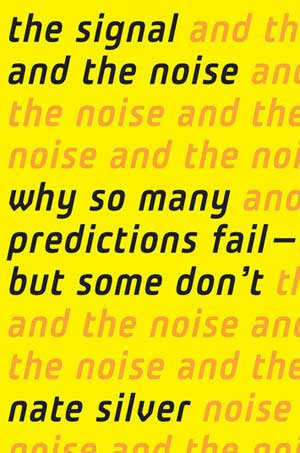 |
| Amazon |
 |
Political news, and especially the important news that really affects the campaign, proceeds at an irregular pace. But news coverage is produced every day. Most of it is filler, packaged in the form of stories that are designed to obscure its unimportance. Not only does political coverage often lose the signal -- it frequently accentuates the noise."
After the jump, my review.
Grade: B+
Poker, Sports, Politics, Weather. Everything you need to know of statistics in everyday life.
Nate Silver made a name for himself by accurately forecasting the results of the 2012 presidential election. By analyzing dozens of polls, he gave President Obama a greater than 90% chance of re-election. Nevertheless, Governor Mitt Romney was equally convinced that he was going to win.
Forecasting elections was just the latest application of statistics that Nate Silver had made a living from. Earlier, he had developed a statistical analysis system for judging the value of major league baseball players. For a time, Silver was a professional poker player, perhaps the ultimate game of statistics. In this book, he broadens his attention to fields as diverse as forecasting the weather, earthquakes, the flu, the stock market, and terrorist attacks. He explains the power, and limitations, of trying to make forecasts in these realms. He explains and promotes an attitude change that is captured by a mathematical formula called Bayes's theorem. For all this, there's very little math in the book, which is a very readable account about a very technical subject.
The strength and weakness of the book is captured in the subtitle: "Why so many predictions fail -- but some don't." It's nuance. If Silver were just trying to sell books, he'd take a controversial stand and push that. Something like: "Don't believe anyone who claims to know the future. Here's why." Or "I predicted the future. Here's how you can, too." Instead, Silver emphasizes the need for a better understanding of uncertainty and how that can inform our estimates of the probability of future events. It won't make you infallible, but it will improve your odds.
This nuance is captured in a series of statements regarding investing in the stock market. The first is simple and absolute:
"No investor can beat the stock market."
Simple and absolute is a crude approximation, of some use, but hardly the only word. The last statement is nuanced and much more accurate:
"It is hard to tell how many investors beat the stock market over the long run, because the data is very noisy, but we know that most cannot relative to their level of risk, since trading produces no net excess return but entails transaction costs, so unless you have inside information, you are probably better off investing in an index fund."
If you're looking for advice on how to make predictions that are simple and absolute, this book is not for you. Simple and absolute are incompatible with the uncertainty surrounding every forecast. But if you want to understand why so many predictions fail -- but some don't -- the nuance in this book is just what you should read. I'm certain of it.

No comments:
Post a Comment